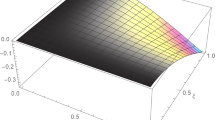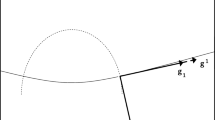Abstract
This study is a continuation of the article “Formulation and solution of a generalized Chebyshev problem: First Part,” in which a generalized Chebyshev problem was formulated and two theories of motion for nonholonomic systems with higher order constraints were presented for its solution. These theories were used to study the motion of the Earth’s satellite when fixing the magnitude of its acceleration (this was equivalent to imposing a third-order linear nonholonomic constraint). In this article, the second theory, based on the application of the generalized Gauss principle, is used to solve one of the most important problems of control theory: finding the optimal control force that translates a mechanical system with a finite number of degrees of freedom from one phase state to another in the specified time period. The application of the theory is demonstrated by solving the model problem of controlling the horizontal motion of a cart bearing the axes of s mathematical pendulums. Initially, the problem is solved by applying the Pontryagin maximum principle, which minimizes the functional of the square of the desired horizontal control force, which transfers the mechanical system from a motionless state to a new motionless state in the specified time period with the cart’s horizontal displacement S (the vibration damping problem is considered). This approach is called the first method for solving the control problem. It is shown that a (2s + 4)-order linear nonholonomic constraint is continuously fulfilled. This suggests applying the second theory of motion for nonholonomic systems with higher order constraints to the same problem (see the previous article), the theory developed at the Department of Theoretical and Applied Mechanics of the Faculty of Mathematics and Mechanics of St. Petersburg State University. This approach is called the second method for solving the problem. Calculations are performed for the case s = 2 and show that the results of both methods are practically identical for a short motion of the system but they differ substantially for a long motion. This is due to fact that the control determined using the first method contains harmonics with the system’s natural frequencies, which tends to bring the system into resonance. For a short motion this is not noticeable, and for a long motion there are large fluctuations in the system. In contrast, when the second method is used, the control is polynomial in time, which provides a relatively smooth motion of the system. In addition, in order to eliminate the jumps in the control force at the beginning and end of the motion, it is proposed to solve the generalized boundary value problem. Some special cases occurring when using the second method for solving the boundary value problem are discussed.





Similar content being viewed by others
REFERENCES
N. N. Polyakhov, S. A. Zegzhda, and M. P. Yushkov, Theoretical Mechanics (Yurait, Moscow, 2015) [in Russian].
F. L. Chernous’ko, L. D. Akulenko, and B. N. Sokolov, Vibration Control (Nauka, Moscow, 1980) [in Russian].
L. S. Pontryagin, V. G. Boltyanskii, R. V. Gamkrelidze, and E. F. Mishchenko, The Mathematical Theory of Optimal Processes (Nauka, Moscow, 1983; Gordon and Breach, New York, 1986).
S. A. Zegzhda, Sh. Kh. Soltakhanov, and M. P. Yushkov, Equations of Motion of Nonholonomic Systems and Variational Principles of Mechanics. A New Class of Control Problems (Nauka, Moscow, 2005) [in Russian].
S. A. Zegzhda, Sh. Kh. Soltakhanov, and M. P. Yushkov, Non-Holonomic Mechanics. Theory and Applications (Nauka, Moscow, 2009) [in Russian].
S. A. Zegzhda, M. P. Yushkov, Sh. Kh. Soltakhanov, and E. A. Shatrov, Non-Holonomic Mechanics and Control Theory (Nauka, Moscow, 2018) [in Russian].
S. A. Zegzhda, Sh. Kh. Soltakhanov, and M. P. Yushkov, Motion Equations of Non-Holonomic Systems and Varitional Principles of Mechanics. New Class of Control Problems (Beijing Institute of Technology Press, Beijing, 2007) [in Chinese].
Sh. Kh. Soltakhanov, M. P. Yushkov, and S. A. Zegzhda, Mechanics of Non-Holonomic systems. A New Class of Control Systems (Springer-Verlag, Berlin, 2009).
M. P. Yushkov, “Formulation and solution of a generalized Chebyshev problem. I,” Vestn. St. Petersburg Univ.: Math. 52, 436–451 (2019).
N. N. Polyakhov, S. A. Zegzhda, and M. P. Yushkov, “The extension of Gauss’ principle to the case of high-order nonholonomic systems,” Dokl. Akad. Nauk SSSR 269, 1328–1330 (1983).
N. N. Polyakhov, S. A. Zegzhda, and M. P. Yushkov, “Linear transformations of forces and a generalized Gauss principle,” Vestn. Leningr. Univ., Ser. 1: Mat., Mekh., Astron., No. 1, 73–79 (1984).
M. A. Chuev, “The analytical method for the synthesis of mechanism,” Izv. Vyssh. Uchebn. Zaved., Mashinostr. 8, 165–167 (1974).
G. V. Kostin and V. V. Saurin, “Integro-differential approach to solving problems of linear elasticity,” Dokl. Phys. 50, 535–538 (2005).
G. V. Kostin and V. V. Saurin, “Modeling and optimization of elastic system motions by the method of integro-differential relations,” Dokl. Math. 408, 469–472 (2006).
S. A. Zegzhda, P. E. Tovstik, and M. P. Yushkov, “The Hamilton–Ostrogradskii generalized principle and its application for damping of oscillations,” Dokl. Phys. 57, 447–450 (2012)
Sh. Kh. Soltakhanov, “Suppression of the cantilever’s vibration,” Vestn. S.-Peterb. Univ., Ser. 1: Mat., Mekh., Astron., No. 4, 105–112 (2009).
Sh. Kh. Soltakhanov, Determination of Control Forces with High Order Constraints (Nauka, Moscow, 2014) [in Russian].
S. Zegzhda, M. Yushkov, Sh. Soltakhanov, N. Naumova, and T. Shugaylo, “A novel approach to suppression of oscillations,” Z. Angew. Math. Mech. 98, 781–788 (2018).
S. A. Zegzhda and Sh. Kh. Soltakhanov, “Application of the generalized Gaussian principle to the problem of damping vibrations of mechanical systems,” J. Comput. Syst. Sci. Int. 49, 186–191 (2010).
C. A. Zegzhda and M. P. Yushkov, “Mixed problem of dynamics,” Dokl. Akad. Nauk 374, 628–630 (2000).
S. A. Zegzhda, “Application of a generalized Lagrange operator for nonholonomic high-order constraints,” Vestn. S.-Peterb. Univ., Ser. 1: Mat., Mekh., Astron., No. 2, 76–77 (1998).
S. A. Zegzhda and D. N. Gavrilov, “Damping of vibration of an elastic body during its motion,” Vestn. S.-Peterb. Univ., Ser. 1: Mat., Mekh., Astron., No. 3, 73–83 (2012).
S. A. Zegzhda, E. A. Shatrov, and M. P. Yushkov, “A new approach to finding the control that transports a system from one phase state to another,” Vestn. St. Petersburg Univ.: Math. 49, 183–190 (2016).
S. A. Zegzhda, E. A. Shatrov, and M. P. Yushkov, “Suppression of oscillation of a trolley with a double pendulum by means of control of its acceleration,” Vestn. S.-Peterb. Univ., Ser. 1: Mat., Mekh., Astron. 3, 683–688 (2016).
E. A. Shatrov, “The use of master coordinates in the problem of damping the vibration of a trolley with two pendulums,” Vestn. S.-Peterb. Univ., Ser. 1: Mat., Mekh., Astron. 1, 619–623 (2014).
Sh. Kh. Soltakhanov, “On a generalized representation of control forces providing a given program of motion,” Vestn. Leningr. Univ., Ser. 1: Mat., Mekh., Astron., No. 2, 70–75 (1990).
Sh. Kh. Soltakhanov, “About one modification of the Polyakhov–Zegzhda–Yushkov principle,” Vestn. Leningr. Univ., Ser. 1: Mat., Mekh., Astron., No. 4, 58–61 (1990).
Sh. Kh. Soltakhanov, “Comparative analysis of equations of motion of nonholonomic systems based on the principle of Polyakhov–Zegzhda–Yushkov and Nordheim–Dolapchiev (the Mangeron–Deleanu principle),” in Problems of Mechanics and Control. Nonlinear Dynamic Systems (Permsk. Gos. Nats. Issled. Univ., Perm, 1997), Vol. 29, pp. 136–148 [in Russian].
Sh. Kh. Soltakhanov and M. P. Yushkov, “The application of a generalized Gauss principle to generating the equations of motion of systems with the third-order nonholonomic constraints,” Vestn. Leningr. Univ., Ser. 1: Mat., Mekh., Astron., No. 3 (15), 77–83 (1990).
Sh. Kh. Soltakhanov and M. P. Yushkov, “Equations of motion of a nonholonomic system with second-order constraint,” Vestn. Leningr. Univ., Ser. 1: Mat., Mekh., Astron., No. 4, 26–29 (1991).
Sh. Kh. Soltakhanov and M. P. Yushkov, “Determination of a minimal derivative of additional force providing a given program motion,” Vestn. Leningr. Univ., Ser. 1: Mat., Mekh., Astron., No. 1, 97–101 (1993).
Sh. Kh. Soltakhanov and M. P. Yushkov, “Determination of a vector structure of high-order constraint reactions,” in Theoretical Mechanics (Mosk. Gos. Tekh. Univ. im. N. E. Baumana, Moscow, 1996), Vol. 22, pp. 30–34 [in Russian].
M. P. Yushkov, “Motion equations of a machine unit with a variator as a nonholonomic system with a nonlinear second-order constraints,” Mekh. Tverd. Tela, No. 4, 40–44 (1997).
V. V. Dodonov and M. P. Yushkov, “Determination of a control moment transferring a rigid body from one angular coordinate position to another by means of minimization of different functionals,” in Proc. 12th All-Russ. Congr. on Fundamental Problems of Theoretical and Applied Mechanics, Ufa, Russia, Aug. 19–24, 2019 (Bashk. Gos. Univ, Ufa, 2019), Vol. 1, pp. 199–200.
Sh. Kh. Soltakhanov, T. S. Shugaylo, and M. P. Yushkov, “Applying the generalized Gauss principle to damping the vibration of a cargo carried by a bridge crane with the motion phase as one of a rigid body,” in Proc. 12th All-Russ. Congr. on Fundamental Problems of Theoretical and Applied Mechanics, Ufa, Russia, Aug. 19–24, 2019 (Bashk. Gos. Univ, Ufa, 2019), Vol. 1, pp. 271–273.
K. M. Fazlyeva and T. S. Shugaylo, “Control of the damping the vibration of a three-mass system during its horizontal motion,” in Proc. Seminar on Computer Methods in the Continuum Mechanics, 2018–2019 (S.-Peterb. Gos. Univ., St. Petersburg, 2019), pp. 56–67.
T. S. Shugaylo and M. P. Yushkov, “Motion control of a gantry crane with a container,” in Proc. Int. Sci. Conf. on Mechanics — 8th Polyakhov’s Reading, St. Petersburg, Jan. 29 – Feb. 2, 2018 (American Institute of Physics, Melville, N. Y., 2018), in Ser.: AIP Conference Proceedings, Vol. 1959, paper no. 030021.
Author information
Authors and Affiliations
Corresponding author
Additional information
Translated by E. Oborin
About this article
Cite this article
Yushkov, M.P. Formulation and Solution of a Generalized Chebyshev Problem: Second Part. Vestnik St.Petersb. Univ.Math. 53, 459–472 (2020). https://doi.org/10.1134/S1063454120040111
Received:
Revised:
Accepted:
Published:
Issue Date:
DOI: https://doi.org/10.1134/S1063454120040111




